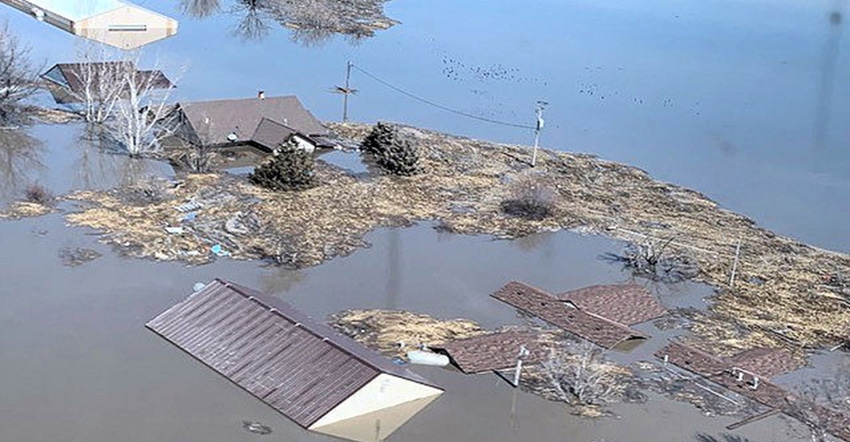May 13, 2019

By Tom Waters
This spring’s Bomb Cyclone which destroyed so much grain, equipment, property and belongings across the western corn belt was a disaster that could have, to some extent, avoided. But, as we described in part one of this series, a river system that was originally designed for navigation and flood control has now been weakened by increasing numbers of experiments related to the Endangered Species Act. In part two we described the government’s costly experiments to save two fish and one bird species, undermining earlier efforts to focus on navigation and flood control along the Missouri River.
Economic value
Some will say let’s just move everyone and everything out of the floodplain and allow the river to run wild. These uneducated scholars do not understand the economic value of the farmland found in the nation’s bottomlands. In Missouri alone, over one third of crop production is located in the fertile river valleys. The highly productive soil found adjacent to the nation’s rivers makes our country strong. A hundred thousand acres of river bottomland can produce enough calories to feed over one Million people for an entire year. What a waste it would be to allow rivers to run wild and destroy such a valuable part of our nation’s strength.
Food production makes the United States strong. Sure, the United States has the strongest military in the world, but as a peaceful nation, food is the most powerful tool we can use before turning to the use of bullets.
Following the 1993, and 2011 floods on the Missouri River, the greatest recovery expenses were related to agriculture. It only makes sense to protect the rich farmland along the River. To do this, flood control must be the top priority and the ludicrous practice of “connecting the river to the floodplain” must stop. Levees and other flood control infrastructure must be improved and the system must be managed to provide the protection it was designed to provide.
It took a long time to tear down the once highly designed system and it will take time to bring it back to the level of protection it once provided. But with Congress designating flood control as the top priority, these changes can begin.
At the same time, fish and birds can survive, a safe water supply can continue, barges can ply the river and the other uses can flourish. Making flood control the top priority does not mean an end to all other uses and purposes for the River. It simply means the U.S. Army Corps of Engineers will use the system as originally designed: to protect human lives and property.
More flooding ahead?
Meanwhile, the flooding for this year is likely not over. The system is primed for more flooding and the Missouri River could reach even higher levels at some locations than we saw earlier this year. A second storm in the plains of the upper basin dumped more rain and snow, all of which must eventually move through the system.
The Corps of Engineers will have to increase releases to move water from the upper basin reservoirs. In addition, The Corps will need to begin making releases from reservoirs in Kansas which have been holding water back to aid with flooding downstream of Kansas City.
The combination of releases from Kansas and the Upper Basin will keep the river high through the spring and summer. Heavy rains anywhere along the river will likely cause additional flooding this year.
With over 100 levees already breached and communities and property left unprotected, the combination of reservoir releases and heavy rainfall this spring or summer could bring even more heartache and devastation to the Missouri River Basin.
This, as recovery begins and the people along the Missouri River seek help to put their lives and livelihoods back together.
It takes all of Congress
The Congressional Delegations in the Midwest cannot do it by themselves. It will take the entire Congress to understand and fix the problem.
The decline of our flood control infrastructure is not limited to the Missouri River. Flooding occurs nearly every day somewhere in the United States. In his testimony during a recent U.S. Senate Committee on Environment and Public Works field hearing, Major General Scott A. Spellmon, Deputy Commanding General for Civil and Emergency Operations, United States Army Corps of Engineers, opened his remarks with a brief review of the many places across the country impacted by flooding this year. He said, “At one point, over 300 river gauges indicated a flood stage somewhere in the Nation, and there were over 183 reported ice jams on rivers across the northern portion of the country.”
He went on to describe flooding occurring in Ohio, the Vicksburg Corps District, the Corps’ Memphis District, North Dakota, Colorado, California, Oregon and of course along much of the Missouri River.
The long list of flooding locations serves to remind us the lack of attention to flood control infrastructure over the past several years is a national problem, which impacts nearly every corner of the country.
The lack of emphasis on flood control over the past 20-plus years and the current inadequate infrastructure must be addressed as a national priority. Congress must act together to correct the problem. Floods do not discriminate. They do not choose democrats over republicans or vice versa. Floods don’t choose rich over poor, north over south or east over west. Flood control is not a partisan issue. It is an issue impacting the entire country and as such, the entire Congress should support prioritizing flood control first.
Without flood control, nothing else matters.
Tom Waters is Chairman of the Missouri Levee and Drainage District Association. He operates his family farming business in the Missouri River bottoms East of Kansas City, Missouri.
You May Also Like




